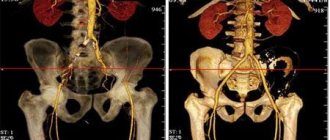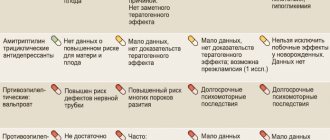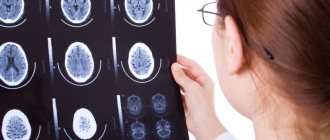Electroencephalography is a modern diagnostic method that helps determine the parameters of the brain.
At the Yusupov Hospital, functional diagnostic doctors perform all types of EEG studies: standard daytime electroencephalography, EEG monitoring of day and night sleep, 24-hour study of bioelectrical activity of the brain. Thanks to the neurology clinic being equipped with modern diagnostic equipment, the quality of the research complies with European protocols.
What are the rhythms?
The rhythms generated by the brain differ into five types depending on the amplitude and frequency of vibrations:
- The alpha rhythm is recorded in 95% of healthy patients at the moment of relaxation, when they close their eyes. Best expressed in the occipital regions. α-wave frequency 8-12 Hz. With visual stimuli, there is a deficiency of this radiation. At the same time, in people with congenital blindness or optic nerve atrophy, the α rhythm is absent.
- Beta rhythms are the fastest brain oscillations in the range of 12-40 Hz. They are associated with the processes of learning and concentration. Therefore, they are formed in a child during the development of logical thinking. Normally, this process ends by age five. Beta waves are generated naturally when you are awake. Under stress, their level increases, but a deficiency, on the contrary, is associated with absent-mindedness syndrome, depression and emotional disorders. Without β-activity, no meaningful human activity is possible.
- The gamma rhythm is clearly visible when solving complex problems. These are the highest frequency rhythms generated during an active thought process. Completely disappears in the deep sleep phase.
- The delta rhythm is characteristic of the recovery period and natural sleep. These are the slowest waves. They are formed in the prenatal period. Asynchronous delta waves appear during coma or drug intoxication.
- Theta activity manifests itself in the fetus already at 2-3 months and predominates in children under three years of age. They represent patterns of electrical activity in the range of 4-8 Hz. Normally, theta waves of an adult appear in the twilight state, during the transition from sleep to wakefulness. A significant number of them can be observed in a confused state, with mental disorders. A large amount of θ rhythm can signal a state of chronic stress.
What does an EEG (electroencephalogram) of the brain show?
EEG helps monitor changes in the brain, both structural and reversible. This allows you to monitor the activity of a vital organ during therapy and adjust the treatment of identified diseases.
Indications for an electroencephalogram
Before prescribing an encephalography to a patient, a specialist examines the person and analyzes his complaints. The following conditions may be the reason for an EEG:
- sleep problems - insomnia,
- frequent awakenings, sleepwalking;
- regular dizziness, fainting;
- fatigue and constant feeling of tiredness;
- causeless headaches.
Insignificant, at first glance, changes in well-being may be the result of irreversible processes in the brain. Therefore, doctors may prescribe an encephalogram if they detect or suspect pathologies such as:
- vascular diseases of the neck and head;
- vegetative-vascular dystonia, disruptions in cardiac activity;
- condition after a stroke;
- speech delay, stuttering, autism;
- inflammatory processes (meningitis, encephalitis);
- endocrine disorders or suspected tumor foci.
An EEG study is considered mandatory for people who have suffered head trauma, neurosurgical surgery, or suffering from epileptic seizures.
How to prepare for research
Monitoring electrical activity in the brain requires little preparation. For the reliability of the results, it is important to follow the basic recommendations of the doctor. Do not use anticonvulsants, sedatives, or tranquilizers 3 days before the procedure. 24 hours before the test, do not drink any carbonated drinks, tea, coffee or energy drinks. Avoid chocolate. No smoking. On the eve of the procedure, thoroughly wash your scalp. Avoid the use of cosmetics (gels, varnishes, foams, mousse). Before starting the study, you need to remove all metal jewelry (earrings, chain, clips, hairpins). Hair should be loose - all kinds of braiding must be unbraided. You need to remain calm before the procedure (avoid stress and nervous breakdowns for 2-3 days) and during it (do not be afraid of noises and flashes of light). An hour before the examination you need to eat well - the examination is not carried out on an empty stomach.
How is an electroencephalogram performed?
The electrical activity of brain cells is assessed using an encephalograph. It consists of sensors (electrodes) that resemble a swimming pool cap, a block and a monitor, where the monitoring results are transmitted. The study is carried out in a small room that is isolated from light and sound. The EEG method takes little time and includes several stages: Preparation. The patient takes a comfortable position - sits on a chair or lies down on the couch. Then the electrodes are applied. The specialist puts a “cap” with sensors on the person’s head, the wiring of which is connected to the device, which records the bioelectric impulses of the brain. Study. After turning on the encephalograph, the device begins to read information, transmitting it to the monitor in the form of a graph. At this time, the power of electric fields and its distribution in different parts of the brain can be recorded. Use of functional tests. This is performing simple exercises - blinking, looking at flashes of light, breathing rarely or deeply, listening to sharp sounds. Completion of the procedure. The specialist removes the electrodes and prints out the results.
How long does the procedure take?
A regular encephalogram is a routine EEG or diagnosis of a paroxysmal state. The duration of this method depends on the area being studied and the application in monitoring functional tests. On average, the procedure does not take more than 20–30 minutes. During this time, the specialist manages to carry out: rhythmic photostimulation of different frequencies; hyperventilation (breaths are deep and rare); load in the form of slow blinking (open and close your eyes at the right moments); detect a number of functional changes of a hidden nature.
Your health is in your hands!
In the LLC “Consultative and Diagnostic Clinic named after E.M. Niginsky" you can undergo an electroencephalogram of the brain.
Reception is conducted by highly qualified specialists.
To make an appointment with specialists and get the necessary information, please call:
+7 or online on the website of the clinic nord - med . ru
Possible contraindications. Specialist consultation required!
Therapeutic effect
Brain wave therapy continues to be studied. According to already available data:
- Alpha rhythms help reduce anxiety, tension and restlessness, and improve memory. It accelerates blood supply to the brain structures, increasing the saturation of the body with oxygen and beneficial microelements. Facilitates the recovery period after illness. Reduces the negative impact of traumatic situations. Determines the release of the neurotransmitter serotonin, increasing its level in the body.
- Beta stimulation helps improve learning, communication skills and perseverance in patients. In addition, such exposure helps reduce fatigue.
- The effect of gamma rhythms has proven itself to be effective in enhancing the speed of information processing and stimulating short-term memory. These frequencies have also been found to have a beneficial effect on the brain in chronic migraine. In approximately half of the subjects, the frequency and intensity of attacks decreases.
- Stimulation of the δ rhythm helps reduce stress levels and relieve attacks of chronic pain, including cephalgia.
- Exposure to θ waves can enhance creativity, improve memory, control over the emotional sphere, and enhance intuition. It helps reduce anxiety and stress, strengthen the immune system, and enhance long-term memory, since the rhythm of theta waves is characteristic of the hippocampus, the part of the brain responsible for storing information and memories.
How to properly prepare for the procedure?
The patient is not advised to take medications several hours before the procedure. 12 hours before this, you should not consume energy drinks or foods with caffeine (coffee, tea, chocolate, sweet carbonated drinks). You need to prepare your scalp in advance, wash your hair, but do not apply sprays, conditioners, varnishes and oils. Cosmetics can weaken the contacts of the electrodes, without obtaining the desired picture at the output. The patient should be calm and relaxed. If the doctor notices increased brain activity, the EEG may be postponed until later, when the person is tired and wants to sleep.
The procedure can be used by anyone. The exceptions include patients with extensive injuries, postoperative sutures or acute infectious processes. EEG is not contraindicated for pregnant women or children, as it does not cause any harm to the body.
Alpha wave stimulation
There are several ways to stimulate the body’s wave activity:
- Breathing exercises that allow you to maintain deep breathing saturate the brain cells with oxygen. Systematic breathing exercises promote the generation of alpha waves.
- Listening to stereo sounds with alpha waves is a technique accessible to everyone.
- Yoga and meditation are powerful activators of the α rhythm.
- Hot baths can help you relax and switch to alpha wave production mode.
Pathological deviations
Disturbances in brain wave activity are observed when:
- Oligophrenia. With it, the total activity of alpha rhythms is abnormally increased.
- Epilepsy, which causes disturbances in the frequency and amplitude of wave activity. This is associated with the development of direct or interhemispheric asymmetry in the hemispheres of the brain.
- Hypertension, weakening the frequency of alpha rhythms and increasing beta activity. Circulatory and cardiovascular system disorders always affect brain wave activity. A similar picture can be observed with beta-lactamase activity of bacteria.
- Paranoid schizophrenia, in which the brain generates an increased number of beta rhythms.
- Cysts and inflammatory processes of the corpus callosum. They cause severe asymmetry between the hemispheres, reaching 30%.
- The pathological picture can occur with traumatic brain injuries, congenital or acquired dementia, and delayed psychomotor development in children.
To evaluate alpha rhythms, it is necessary to undergo an EEG from time to time. You can find out the addresses of clinics that perform this diagnostic procedure on the website.
Indications for an encephalogram
The doctor will definitely prescribe an electroencephalography if the patient has one or more alarming symptoms:
- frequent fainting;
- headache;
- disturbances in sleep phases, falling asleep, insomnia;
- head injuries;
- seizures;
- epileptic seizures;
- neuroses;
- acute cerebrovascular accident;
- degenerative diseases of the brain;
- neuroses;
- nausea and vomiting for no apparent reason;
- hypertension;
- suspicion of stroke, microstroke, cerebral infarction;
- suspected development of a brain tumor.
An encephalogram of the brain is an informative method for diagnosing infectious diseases of the brain and its membranes: encephalitis, meningitis. Electroencephalography may be prescribed during the treatment of these diseases in order to monitor its effectiveness.
An electroencephalogram is necessarily performed as part of preparing the patient for brain surgery.
Electroencephalography is widely used in pediatric practice. The diagnostic method is used for such conditions in children as:
- delayed mental, emotional and speech development;
- somnambulism;
- nervous tic;
- stuttering;
- head injuries;
- convulsive syndrome.
An encephalogram of a child’s brain is an important study in the diagnosis and treatment of children with diseases such as autism, Down syndrome, and cerebral palsy. With the help of an encephalogram, the diagnosis and its severity are clarified, how quickly the pathology progresses, and the effectiveness of treatment.
Due to the fact that the encephalograph does not emit impulses, but only records them, the procedure has no contraindications. The exception is when the patient has wounds on the head that prevent the installation of the electrodes of the device to obtain an encephalogram.
Disadvantages of the method
Excessive wave stimulation can cause negative reactions in the body. So, with an excess of alpha activity, a decrease in concentration develops, the formation of attention deficit, depression, and a decrease in visual clarity. A person begins to need daytime sleep and gets tired faster. In addition, under the influence of alpha waves, suggestibility increases.
The downside of beta wave stimulation is increased anxiety, overexcitement and the development of obsessive-compulsive disorder. There are signs of stress and paranoia. Also, under the influence of such stimulation, muscle tension increases and insomnia occurs. The effect on the cerebellar amygdala and hypothalamus provokes an increase in blood pressure.
When exposed to theta waves, you can develop concentration disorders, depression, hyperactivity, or, conversely, apathy. Under the influence of such stimulation, drowsiness, indifference to life, and increased suggestibility occur.
Therefore, before resorting to any methods of stimulating brain wave activity, it is better to consult with specialists.
A way to stimulate the brain by changing your diet
How to increase brain activity with nutrition? There is a traditional and a paradoxical way.
- The traditional method involves eating “brain foods.” These traditionally include:
- Omega-3-containing foods - fatty fish, flaxseed and oil, nuts, wheat germ and other grains,
- antioxidant products - liver (vitamin A and zinc), vegetables (vitamin C), fermented milk products (glitathione), wine, etc.
- coffee in combination with green tea - in this combination, high mental activity can last all day without negative consequences.
- The paradoxical method involves the use of short-term fasting. This is an extreme method, designed for tactical needs, which is based on the idea of scientists at Yale Medical School. In their opinion, mental activity becomes high if the brain “thinks” that the body needs food, and whether it receives nutrition depends on such activity. This evolutionary dependence was confirmed by experiments on hungry mice, which demonstrated greater intelligence than their well-fed counterparts.









